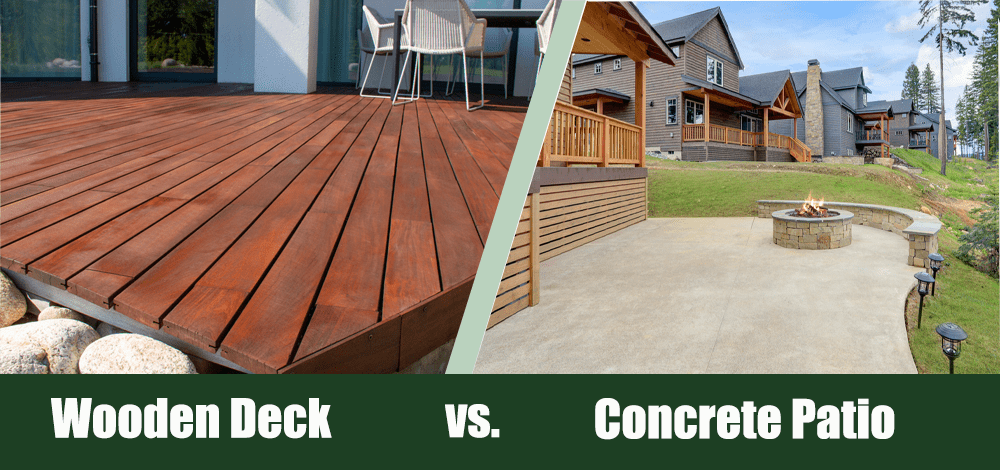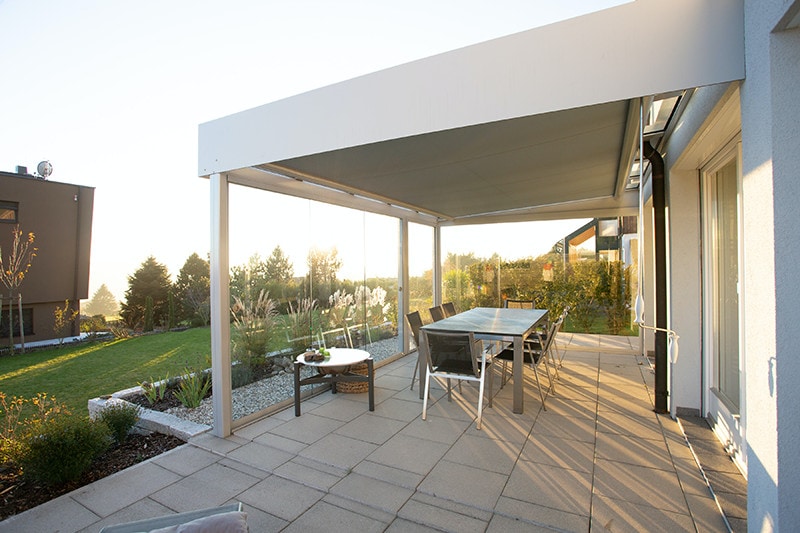Wooden Deck vs Concrete Patio: What’s the Difference?
-
Pete Ortiz
- Last updated:

Outdoor spaces are a huge consideration in today’s real estate market. You can raise your property’s market value by installing a new outdoor space area. However, you need a carefully thought-out layout of your outdoor area to maximize the potential uses. The two most common outdoor space construction options are concrete patios and wooden decks. They both offer unique benefits, but what are the differences between the two?
This article will highlight the differences between them to help you choose an option that best suits your style. Read on to learn more.
Overview of Wooden Decks
Generally, decks are raised platforms constructed from different materials, including wood, PVC, treated lumber, and composite, among others. Unlike patios, decks are attached to the main family house; however, they can be stand-alone as well. Decks can be built high above the ground with staircases as the access point or built on the ground but only raised by joists.
Wood is the most preferred material for building decks. Despite where you choose to build your outdoor relaxation area, wooden decks must have strong support ledgers built below the structure. This will help prevent buckling and warping floorboard issues in case there is movement in the foundation.
Uses
Wooden decks are popular platforms for sunrooms, porches, patios, and pools. They are also used as walking paths around homes or in outdoor entertainment areas when hosting friends and family during the warm summertime.

Types of Wooden Decks
When most people think about outdoor areas, they think about elevated wooden platforms. Wooden decks can be built directly atop the soil or erected on top of an existing concrete slab. A deck built on the ground is different from a patio because the deck is supported by joists, while a patio sits directly on top of the soil.
- Elevated Decks – In most neighborhoods, wooden decks are built as an extension of the dining and living areas of the main floor. Since they are constructed from an elevated position, they are suitable for sloping grounds or any other uneven ground. So, elevated wooden decks work well in homes located in hilly areas.
- Ground-level Deck – Despite what the name may suggest, ground-level decks are not built directly on top of the soil. Sure, they may be close to the ground; however, they still require a raised substructure underneath. Sometimes, these decks are built with a staircase for easier access to the deck. Ground-level decks require minimal maintenance compared to the raised decks and don’t require attaching to the main house to improve stability.
- Ideal for sloping or uneven terrain
- They retain the natural appearance, texture, and color of different wood species
- Comfortable to sit under in hot weather
- Eco-friendly if made from sustainably produced wood
- Cheaper compared to composite materials (depends on the type of wood used)
- Easier to construct, making them ideal for DIY home projects
- Require building permits and other certifications before construction
- Are susceptible to damage from termites and mold if not protected
- More expensive when compared to concrete patios
- Feature weight limit restrictions, making them unsuitable for the installation of hot tubs or other creature comforts

 Overview of Concrete Patios
Overview of Concrete Patios
A patio simply refers to a paved outdoor space built next to the main house. It serves as an extension of the living quarters, whether constructed in front or at the back of your yard. You can also add shelves, tables, and chairs for comfort and improve the aesthetic appeal of your patio. There are different types of patios that you can use in your outdoor spaces to imitate the natural look of stone. They include concrete, paver, raised, and stone patios.
Concrete patios are very different from wooden decks in terms of construction, feel, and appearance. For starters, unlike wooden decks built on raised platforms, concrete patios require a flat area. Usually, they are built on level grounds in backyards to store furniture and appliances. While cement is the most commonly used material in making concrete patios, there are other materials you can use to upgrade the cement slab. Concrete patios are preferred by many homeowners because they are affordable, durable, and easy to maintain more than other types of patios.

How Are Concrete Patios Made
Concrete patios are made from a cement slab that is poured on the floor as a surface for the outdoor space. Also, the concrete mix must be mixed and applied in large forms, which can take hours, if not days, to completely dry.
The main challenge associated with making concrete patios is the lime limitation in placing the concrete. Unlike wooden decks where you can pause to take a breather, you must finish applying concrete within the required timeframe, which can be a few hours only.
Due to the limited time frame, it helps if you seek help from several skilled people to assist in applying the concrete flooring. You might be tempted to ask for help from your neighbors or friends, but building patios is not an easy DIY project. If you don’t do it right, you will regret it.
- Very versatile, allowing homeowners to build any kind of shape, provided there is enough space
- Durable and are not affected by issues such as rot from termite infestations
- Can build sturdy concrete patios using stamped pavers to give them a Mediterranean countenance
- Safe for using wood-burning fire pits
- Ideal for areas around swimming pools
- Are unsuitable for installation on sloppy or uneven ground
- Adds less value to a property compared to wooden decks
- Unless sealed, they are vulnerable to cracking caused by moisture deposits

 Differences Between a Wooden Deck and a Concrete Patio
Differences Between a Wooden Deck and a Concrete Patio
1. Materials and Location
Wooden Decks
The materials used to make these two outdoor space areas are perhaps the most obvious difference between the two. As the name suggests, wooden decks are made from wood and are usually attached to the underlying home structure. Since wooden decks are raised platforms, they are suitable for uneven terrain.
The deck can even be an access platform to the second-story deck. Due to their elevated nature, decks also feature guard rails around their perimeter. The extra height created by the raised platform (about one foot from the second-story deck or the ground) allows homeowners to have scenic views of their surrounding areas right from their wooden deck.
Concrete Patios
Concrete patios, on the other hand, are built at ground level and are made from concrete. Since they require installation at the ground level, the surface needs to be evenly spread out. Unlike decks, concrete patios don’t require structural support. Therefore, they can be built free-standing or attached to a structure in your home. They also don’t require the installation of safety rails. Concrete may be the most common type of material used in patios, but materials such as pea gravel and stone pavers are also viable.
2. Cost
Wooden Decks
In the construction industry, building wooden decks incurs more upfront costs when compared to concrete patios. This can be attributed to several factors.
For starters, wood deck construction is more time-consuming and will rack up more bills than simply pouring concrete. Also, concrete is generally cheaper than wood materials. Furthermore, wooden decks require more maintenance practices which will also increase the costs.
Depending on your location, you may have to stain and reseal wood at least once every 10 to 15 years before you replace it. Since it is also vulnerable to termite attacks, upkeep is vital. If you are thinking about moving to a new location, having a wooden deck will offer a higher return on investment than concrete patios. When you sell a home with a wooden deck, you can recover up to 70% of your initial investment.
Concrete Patios
Concrete patios are essentially budget-friendly options for utilizing your outdoor area. However, you must level the ground first before pouring any concrete if you live in an area with uneven terrain. Leveling the land may cost you, but it wouldn’t significantly affect the overall costs. To predict how much it would cost to build your dream concrete patio, use a patio cost estimator.
Furthermore, installing concrete patios is cheaper because they have fewer maintenance requirements. They can last for decades without requiring frequent cleaning. However, they do not offer a great return on investment when compared to wooden decks. You can only get back up to 50% of their value. So, if you want to add an outdoor space to increase your property value, a deck is the better option.

3. Restrictions and Permits
Wooden Decks
Before building any outdoor rest area, you need to confirm the local building laws in your home area. Some states require that you pay permit and inspection fees for building wooden decks. Decks are considered an extension of your home and need to be inspected regularly, just like they do on the house.
In case you are building a second-story deck, safety standards are of vital importance. Home inspectors will be able to tell you the weight restrictions that you have to adhere to. The restrictions are also important because they will help you choose the right furniture for your deck.
Concrete Patios
Building concrete patios involves less hassle because it is not bound by some of the restrictions imposed on wooden decks. This can be attributed to the fact that patios are built on flat land and don’t require any elevated surfaces. So, if you want to avoid the paperwork from your local building authority, a patio is a simpler choice.
4. Environmental Impact and Sustainability
Wooden Decks
Since decks are built mainly from wood materials, it’s wise to invest in durable and hardy wood species like redwood and cedar. These hardy woods will significantly increase the time before your deck needs replacing. This will reduce the number of trees felled to make lumber for construction.
Concrete Patios
Between wooden decks and concrete patios, wood is the most sustainable. Concrete has an incredibly long lifespan before it requires replacing. Besides being durable, it can also be reused or recycled if it gets damaged or is removed.
If you are concerned about the environmental impact of a concrete patio in your backyard, you should consider factors such as the permeability of the concrete. A standard concrete slab is impermeable in water. So, in case of heavy rain, concrete patios will not be able to drain well and possibly create soil erosion and runoff issues.
To avoid these issues, you can opt to use soil cement or porous concrete. These materials are porous enough to allow water to leak through while maintaining the clean appearance of a concrete slab.

 Conclusion
Conclusion
Patios and decks are semi-permanent structures, so you want to choose one that you will enjoy and appreciate without any buyer’s remorse. Before choosing, you must know their differences and characteristics to pick one that suits your structural design and preferences.
The two differ in terms of cost, material composition, permits, restrictions, and environmental impact. Also, both may need maintenance, but maintaining a wooden deck is more demanding, which can increase the overall costs of installing one. Concrete patios are more affordable and durable and can last for years without requiring repair.
Your choice between the two will depend on the size and style of your home and yard and your budget for the project. Also, consider the activities you hope to carry out on your finished structure. Furthermore, you need to consult your local zoning authority for any necessary inspections or permits that your structures may require.
Featured Image Credit: Left : Wooden Deck(Radoslav Cajkovic, Shutterstock) ; Right: Concrete Patio (Artazum, Shutterstock)
Contents


 Conclusion
Conclusion